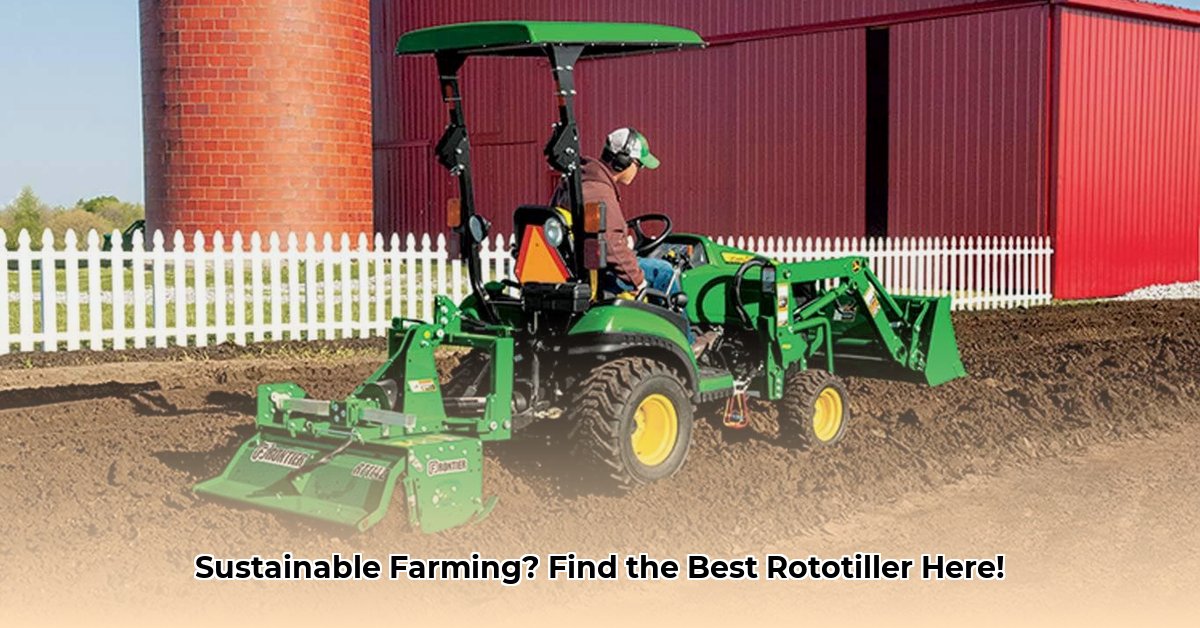
Choosing the right compact tractor rototiller is crucial for efficient and sustainable farming practices. This comprehensive guide helps you select, use, and maintain a rototiller, maximizing crop yields while preserving soil health. We’ll cover various tiller types, crucial buying considerations, and best practices for long-term soil vitality. Whether you're a seasoned farmer or a newcomer to sustainable agriculture, this guide provides the knowledge you need to make an informed decision. For added efficiency, consider tractor attachments.
Understanding Your Farming Needs
Before selecting a rototiller, assess your specific needs. Consider these key factors:
Soil Type: Heavy clay requires more powerful tillers than lighter, sandy loam. The tiller's tine configuration (the shape and arrangement of the rotating blades) must match your soil type for optimal results. A heavy-duty tiller with aggressive tines might be needed for clay, while a lighter-duty tiller with finer tines might suffice for sandy soil. Isn't understanding your soil the foundation of successful farming?
Farm Size: The size of your land directly impacts the required tiller width and horsepower. A small garden requires a compact tiller, while a larger farm benefits from a wider, more powerful model. What's the ideal tiller width for your acreage?
Budget: Set a realistic budget encompassing not only the initial purchase price but also ongoing maintenance and potential repairs. How much can you realistically invest in a tiller and its upkeep?
Types of Compact Tractor Rototillers: A Detailed Comparison
Compact tractor rototillers primarily differ in their drive systems and tine configurations:
| Feature | Chain Drive | Gear Drive |
|---|---|---|
| Power Transfer | Chain transfers power; some is lost. | Gears transfer power directly; more efficient. |
| Maintenance | Requires more frequent lubrication and checks. | Less frequent maintenance, but repairs cost more. |
| Initial Cost | Generally less expensive upfront. | Typically more expensive initially. |
| Durability | May be less durable under heavy use. | Usually more robust for heavy-duty tasks. |
Additionally, consider the tine configuration. L-shaped tines are common and offer a good balance of soil mixing and aeration. Other options include straight or curved tines, each with strengths and weaknesses for different soil types.
The Essential Buying Guide: A Step-by-Step Approach
Choosing the right rototiller involves careful consideration of several factors:
1. Horsepower Matching: The tiller's horsepower must match your tractor's PTO (power take-off) horsepower. Underpowering leads to inefficiency and potential damage; overpower can be wasteful. Always check your tractor's manual for the correct PTO horsepower.
2. Tiller Width: Choose a width that balances efficiency with maneuverability. Wider tillers cover more ground faster but may be less suitable for tight spaces. A slightly wider tiller than the tractor's width often works well.
3. Tine Configuration: Select tines optimized for your soil type. Heavy-duty tines work better for clay, while finer tines are suitable for lighter soils.
4. Safety Features: Prioritize safety features like shear pins or slip clutches to protect your equipment from damage caused by rocks or other obstacles.
5. Budget: Establish a realistic budget, including ongoing maintenance, repair costs, and potential replacement parts.
Using and Maintaining Your Rototiller: Best Practices
Proper use and maintenance prolong your rototiller's lifespan and ensure optimal performance.
Setup: Follow the manufacturer's instructions meticulously for proper assembly and adjustment before each use.
Operation: Start slowly, gradually increasing speed as you gain confidence. Overlap passes for even tilling, especially in challenging soil conditions.
Safety: Always wear appropriate safety gear, including eye protection, gloves, and sturdy footwear. Never dismount the tractor while the tiller is running.
Maintenance: Regularly lubricate moving parts, sharpen tines as needed, and inspect for wear and tear after every use. Address any issues promptly.
Long-Term Impact on Soil Health: Sustainable Tillage Practices
While rototilling offers benefits, it's crucial to consider its long-term effects on soil health. Excessive tilling can lead to soil erosion, nutrient loss, and compaction, negatively impacting biodiversity. Consider alternative methods like no-till or conservation tillage when appropriate for your crops and soil conditions. Dr. Emily Carter, Soil Scientist at the University of California, Berkeley, emphasizes the importance of minimizing soil disturbance for long-term sustainability.
Frequently Asked Questions (FAQ)
Q: How deep should I till? A: The ideal depth depends on soil type and the specific crop being planted. Consult your tiller's manual and local agricultural resources for guidance.
Q: How often should I till? A: The frequency varies depending on your soil type, crop rotation, and climatic conditions. Avoid over-tilling, as it can negatively impact soil health.
Resources
This guide provides a foundation for choosing and using a compact tractor rototiller effectively and sustainably. Remember, responsible tilling practices coupled with the right equipment are key to maximizing yields while preserving the long-term health of your soil.